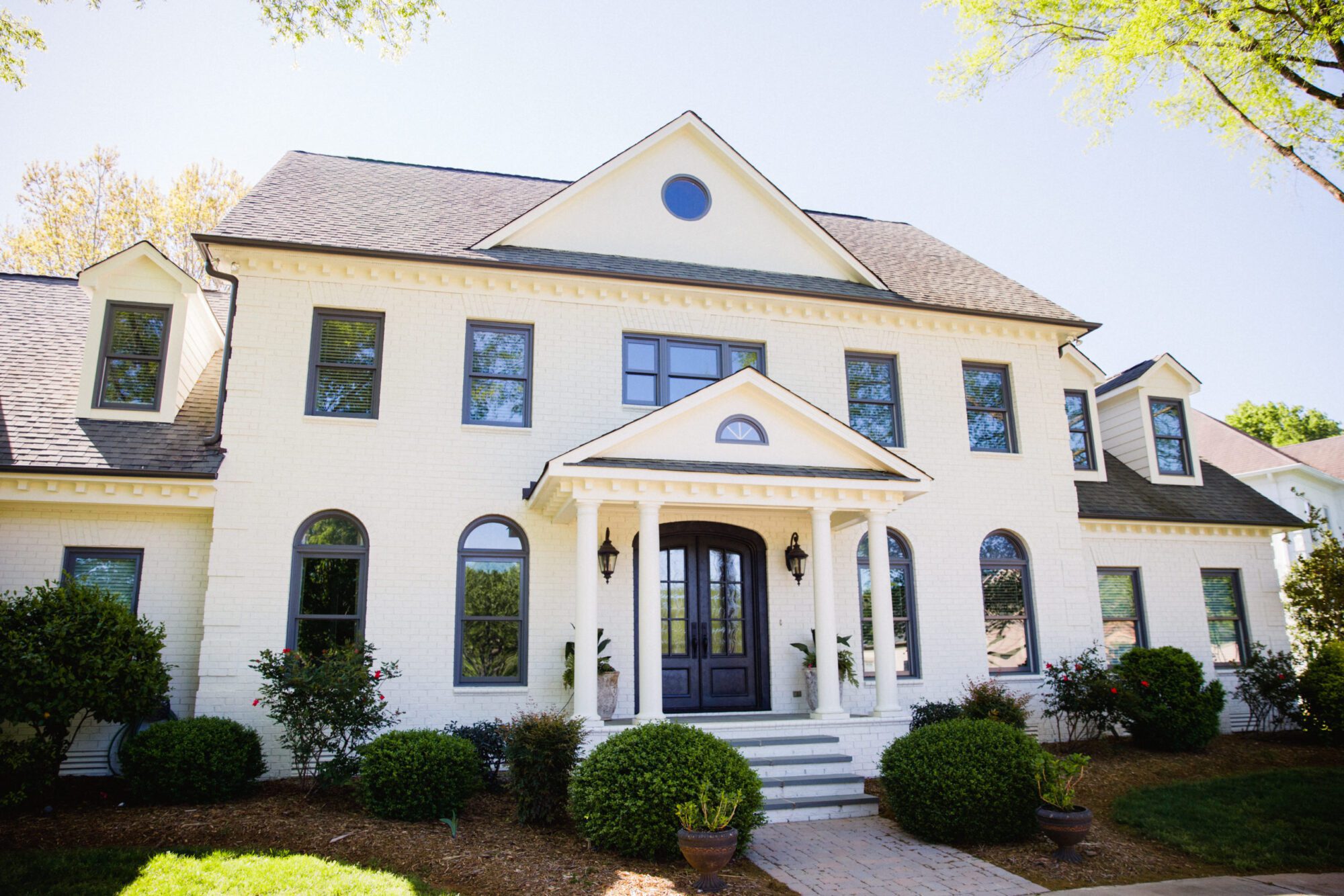The importance of choosing the right door for your home cannot be overstated. As the primary entry point for both you and your guests, the front door sets the stage for the interior look and feel of the rest of the house. But should you choose the more traditional hinge door or select a pivot door for a more sleek, unique design?
While the space of your foyer and the exterior design are important factors to consider, you will also want to think about visual differences, customization options, ease of operation, and more. Explore the differences between pivot doors and hinge doors so that you can make your vision come to life.
What is a Pivot Door?
Pivot doors are some of the most unique, striking door styles on the market today.
Definition and Mechanism
A pivot door is a swinging door that rotates on a vertical axis or spindle. Rather than a traditional hinge door, which is attached to a wall or door frame, a pivot door is in essence a pivoting panel that can be custom designed and fitted to match any kind of space. They consist of:
- A door panel
- A pivot system
- A top pivot
- A floor plate
- A ceiling plate
- Roller catches
None of these parts of the mechanism are visible, though. With a minimalistic look, a pivot door leverages a pivot hinge system and a top pivot that cannot be seen on the finished door.
Examples of Pivot Doors
Clark Hall can custom design the highest-quality iron pivot doors to bring your vision to life. Our iron doors can also be customized to inswing or outswing depending on your preference and design needs.
What is a Hinged Door?
Hinged doors may provide a more conventional look, but they can still be custom-made to match your design needs.
Definition and Mechanism
When you think of a door, you’re most likely going to think of a hinged door. They are one of the most ubiquitous door designs in the world. Two to three hinges fix the door to the doorframe, allowing the door to open and close with ease.
There’s a reason they are so popular: they’re easy to use and they work well. In fact, they can usually be installed with little to no frustration at all–and there’s no learning curve when it comes to using them, because everyone understands how they work.
Examples of Hinged Doors
Clark Hall’s custom-designed iron hinged doors can give your home the facelift you’ve been looking for.
Pivot vs. Hinged: Design and Aesthetics
Before you decide to go with a pivot or hinged door, you need to consider the impact your choice will have on the design and aesthetics of your home.
Visual Differences
It is important to keep in mind that pivot doors are often much taller and wider than hinged doors. If you’re comfortable with expanding the space your front door occupies—or looking to stun your guests with the beauty of a unique custom door—then a pivot door may be the choice for you. If space is an issue for you, you may want to go with the more conventional hinged doors.
Customization Options
Clark Hall is proud to offer customized pivot and hinged doors to make your design dreams a reality. From the initial sketch and design to the final installation, we offer a white-glove experience from start to finish. Each element of your door, from glass to hinge color to pivot point, is hand-selected to bring your vision to life. Be it a pivot door or a hinged door, Clark Hall promises a functional work of art for your home.
Impact on Interior Design
Custom-designed doors promise to change the look and feel of your home. However, there are a few things to consider when selecting between the two. A pivot door will require more space, so you will want to make sure that your entryway can handle the new height and weight without looking crowded. Hinged doors can be made to fit the current space you have now. A hinged door also offers a more traditional look, while the pivot door will revolutionize the face of your home. It offers a more sleek and unique design, so if that is your goal, the pivot door is an easy choice.
Pivot vs. Hinged Doors: Installation, Functionality and Performance
There are a few key differences between pivot and hinged doors, especially when it comes to functionality and performance.
Installation Process
Hinged doors are relatively easy to install, which is part of the reason why they have been so popular for so long. Typically, anywhere from two to four hinges are mounted to a doorframe or a wall depending on the homeowners preference. They will then swing open and closed on the side with the hinges. Hinged doors can also open inward or outward depending on preference.
Pivot doors will require more space than hinged doors, and they are also more difficult to install. They can be designed to open inward or outward depending on your preference. When you select a pivot door through Clark Hall, we remain with you through every step of the process, from the initial design all the way to installation.
Ease of Operation
Hinged doors’ popularity comes from two undeniable facts: they are both easy to install and easy to use. The hinges attach to both the wall and the door, which means the door can open and shut freely. Conversely, pivot doors are usually mounted from the top and bottom near one side of the door. Think of the attachment as a kind of pole through the center of the door, and the door rotating around that pole. It operates more smoothly than a hinged door, and since the door is rotating away from the wall on each side, it offers a far more unique visual, making it revolutionary when it comes to interior design.
Noise and Air Leakage
Hinged doors can be weather sealed, which means less air leakage in the summertime and more insulation come winter time. Pivot doors do not provide the same kind of seal. The same can be said for noise reduction. Pivot doors can be customized to include additional soundproofing. Alternatively, hinged doors come equipped with both sound and weather-sealing capabilities from the jump. Pivot doors also require an ADA threshold which is not adjustable, giving you the tight seal from your interior floor to your exterior floor.
Pros and Cons of Pivot vs. Hinged Doors
As with any design decision, there are pros and cons to choosing pivot doors vs. hinged doors.
Advantages of Pivot Doors
Pivot doors have a lot to offer in terms of both design and functionality. They offer a more sleek, unique look, and they are often more durable, since there are not as many pieces that can become damaged or worn with age. If you want a one-of-a-kind entryway and don’t mind your front door taking up some extra space, a pivot door is the way to go.
Disadvantages of Pivot Doors
Pivot doors are more difficult to install, which means that if you do encounter problems with your door, you will likely need a professional to come out and help you. They also take up more space and tend to cost more. Sometimes, when people select wooden pivot doors, the wood can become warped over time. However, with iron doors designed by Clark Hall, you should not encounter this issue. Be aware of the weather-sealing and noise reduction issues that may present themselves with pivot doors as well.
Advantages of Hinged Doors
Hinged doors are easy to install and easy to use. Almost everyone has encountered hinged doors in their lives, so there will be little to no learning curve for your guests. They also come with weather- and noise-sealing capabilities to reduce heating and air loss during particular times of year. Should you encounter an issue, such as a squeaky hinge, they are relatively easy to fix on your own.
Disadvantages of Hinged Doors
The biggest con to a hinged door is the maintenance over time. Since daily operation places a lot of pressure on the hinges, they are likely to warp or break and so will need to be replaced. Hinged doors require regular oiling to maintain smooth operation. However, handcrafted, custom welded barrel hinges like those used at Clark Hall will definitely last longer.
Pivot vs Hinge Doors – Which to Choose?
When it comes down to brass – or should we say iron? – tacks, selecting a pivot or hinged door for your entryway is a question of style. Do you enjoy a more traditional look and value the easy installation of a hinged door, or are you interested in the one-of-a-kind feel that a pivot door offers?
Regardless of which door you choose, know that Clark Hall is equipped to design a functional work of art worthy of your dream design. Schedule a consultation with our team today.
FAQs
What are the main differences between pivot doors and hinged doors?
Hinged doors differ from pivot doors in four key areas: opening mechanism, design and aesthetic, weight and size, and installation and maintenance. Hinged doors use hinges attached to a door frame or wall, while pivot doors use a pivoting mechanism that allows the door to pivot on a sort of pole and swing open or closed using that mechanism. Hinged doors offer a more traditional look, while pivot doors tend to be more unique in how they move away from each side of the wall. Hinged doors are typically smaller, while pivot doors require more space, and while hinged doors are easier to install, pivot doors require less maintenance because they have less moving parts.
Which is better for energy efficiency?
When it comes to energy efficiency, hinged doors generally perform better than pivot doors. Hinged doors fit tightly into their frames, minimizing air leakage while maintaining indoor temperature. This snug fit reduces the loss of heat or cool air, making hinged doors a more energy-efficient choice compared to pivot doors.
Are pivot doors suitable for all types of climates?
Pivot doors can be designed and installed to suit any climate, though the particular weather conditions of the surrounding areas will determine how much additional insulation and attention is needed. For example, if you live in a climate with more extreme weather conditions–say, with cold winters and hot summers–you will want to make sure your custom pivot door is outfitted with proper weatherstripping and insulation. You will also want to take into account the direction of the door and whether it’s facing into the wind or against the wind prior to making your decision. This can significantly impact the operation of the door. You will also want to have a pivot door under a decent amount of overhang. This will help with wind blowing water in when it rains. Speak with your designer about these concerns prior to installation.






